Unlocking Stroke Severity: Decoding 3 on NIH Scale
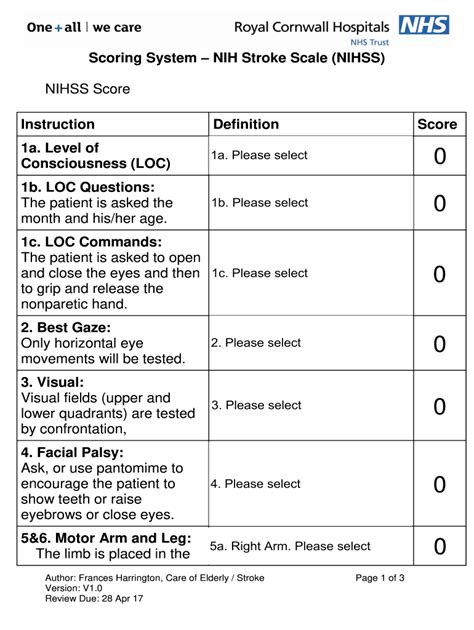
Gain insights into stroke severity assessment with our article on the significance of '3 on NIH Stroke Scale'. Empower your clinical practice today.
In the realm of healthcare, the NIH Stroke Scale serves as a crucial tool in assessing and quantifying the severity of stroke symptoms. Among its various components, the 3 on NIH Stroke Scale holds particular significance, representing a key indicator in determining the degree of neurological impairment. This article endeavors to delve into the intricacies of this specific scoring, shedding light on its implications within the realm of stroke care. From elucidating the significance of each component to exploring its broader implications on patient outcomes, our discussion aims to provide a comprehensive understanding of the 3 on NIH Stroke Scale and its relevance in clinical practice. Through an objective analysis, we aim to empower healthcare professionals and readers alike with valuable insights into this critical aspect of stroke assessment.
Top 10 Points about 3 on NIH Stroke Scale :
- Understanding the NIH Stroke Scale
- Components of the NIH Stroke Scale
- Importance of Scoring '3' on NIH Stroke Scale
- Neurological Implications of a Score of '3'
- Interpreting Stroke Severity with NIH Scale
- Role of NIH Stroke Scale in Clinical Practice
- Management Strategies for Patients with a Score of '3'
- Prognostic Significance of '3' on NIH Stroke Scale
- Rehabilitation Considerations for Stroke Patients
- Advancing Stroke Care Through NIH Stroke Scale Assessment
Several facts about 3 on NIH Stroke Scale
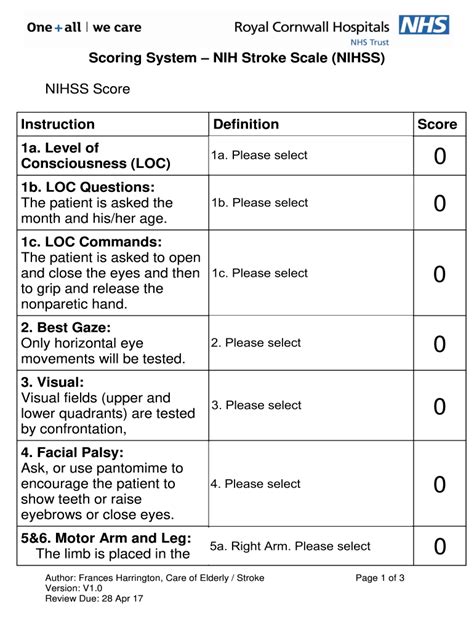
Understanding the NIH Stroke Scale
The NIH Stroke Scale is a widely utilized tool in healthcare settings to assess the severity of stroke symptoms. Developed by the National Institutes of Health (NIH), this scale comprises various components that evaluate different aspects of neurological function.
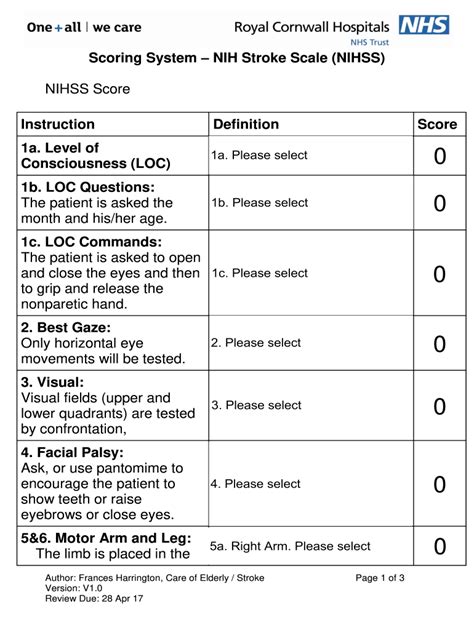
Components of the NIH Stroke Scale
The scale consists of 11 items, each assessing specific functions such as consciousness, vision, facial palsy, motor function, coordination, and language abilities. These items are scored based on the patient's performance, with a higher score indicating greater impairment.
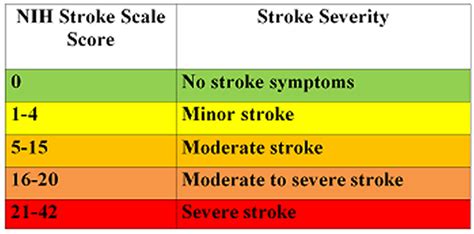
Importance of Scoring '3' on NIH Stroke Scale
Scoring a '3' on the NIH Stroke Scale signifies mild to moderate impairment in a specific component, such as facial palsy or motor function. While not indicative of severe disability, it highlights the need for immediate medical attention and intervention.
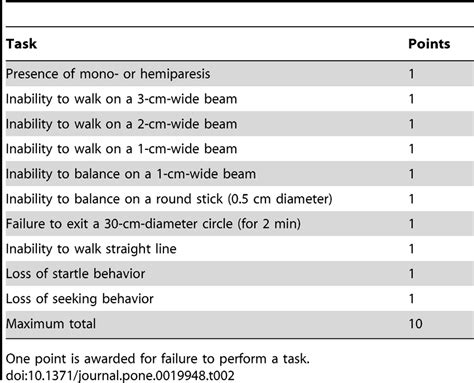
Neurological Implications of a Score of '3'
A score of '3' on the NIH Stroke Scale may indicate subtle neurological deficits that could impact the patient's daily functioning and quality of life. These deficits could manifest as weakness, sensory changes, or other neurological symptoms.

Interpreting Stroke Severity with NIH Scale
Healthcare professionals use the NIH Stroke Scale to assess the severity of a stroke and determine the appropriate course of treatment. A comprehensive understanding of the scale aids in accurately interpreting the extent of neurological impairment.

Role of NIH Stroke Scale in Clinical Practice
The NIH Stroke Scale plays a crucial role in guiding clinical decision-making for stroke patients. It assists healthcare providers in formulating treatment plans, predicting outcomes, and monitoring the patient's progress throughout their recovery journey.
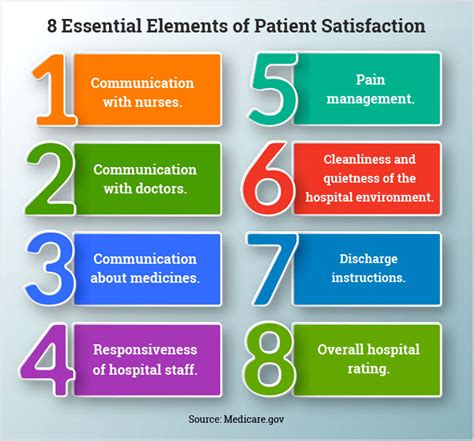
Management Strategies for Patients with a Score of '3'
Patients who score '3' on the NIH Stroke Scale may benefit from a multidisciplinary approach to their care. Treatment strategies may include physical therapy, occupational therapy, speech therapy, medications, and lifestyle modifications to optimize their recovery.
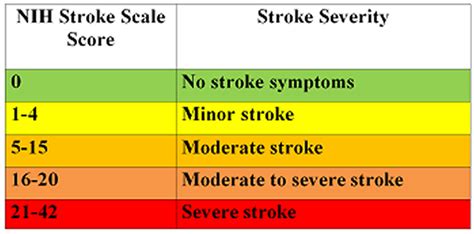
Prognostic Significance of '3' on NIH Stroke Scale
While a score of '3' indicates mild to moderate impairment, it can still serve as a prognostic indicator for the patient's recovery trajectory. Healthcare providers use this information to estimate the likelihood of functional improvement and tailor interventions accordingly.

Rehabilitation Considerations for Stroke Patients
Rehabilitation is a crucial aspect of care for patients who have experienced a stroke. Individuals with a score of '3' on the NIH Stroke Scale may benefit from early and intensive rehabilitation interventions aimed at maximizing their functional abilities and promoting independence.
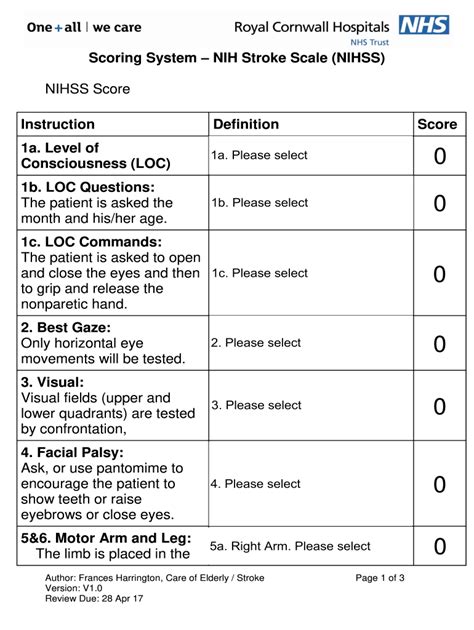
Advancing Stroke Care Through NIH Stroke Scale Assessment
By incorporating the NIH Stroke Scale into routine clinical practice, healthcare providers can enhance the quality of stroke care delivery. Timely and accurate assessment using this scale facilitates prompt intervention, improves patient outcomes, and contributes to the advancement of stroke management strategies.
Sources:
- "National Institutes of Health Stroke Scale (NIHSS)." National Institutes of Health Stroke Scale (NIHSS) - MDCalc. https://www.mdcalc.com/national-institutes-health-stroke-scale-nihss
- "The National Institutes of Health Stroke Scale (NIHSS)." National Institute of Neurological Disorders and Stroke. https://www.ninds.nih.gov/disorders/clinical-trials/national-institutes-health-stroke-scale-nihss
3 on NIH Stroke Scale in Professional's eye
In the realm of healthcare, the
NIH Stroke Scale serves as a foundational tool for evaluating the severity of stroke symptoms and guiding treatment decisions. One crucial aspect of this scale is the assessment of a
score of '3', which signifies mild to moderate impairment in specific neurological functions. Understanding the implications of this score is essential for healthcare professionals involved in the care of stroke patients. When a patient presents with a
score of '3' on the NIH Stroke Scale, it indicates the presence of subtle neurological deficits that could potentially impact their daily functioning and quality of life. These deficits may manifest as weakness, sensory changes, or other neurological symptoms. Therefore, prompt and accurate assessment of this score is paramount in initiating appropriate interventions to optimize patient outcomes. Healthcare providers must utilize their expertise to interpret the significance of this score within the context of each individual patient's presentation and medical history. By employing a multidisciplinary approach to care, including physical therapy, occupational therapy, speech therapy, and medication management, providers can address the specific needs of patients with a
score of '3' on the NIH Stroke Scale. Additionally, ongoing monitoring and reassessment are crucial to track the patient's progress and adjust treatment strategies as needed. Ultimately, a comprehensive understanding of the
NIH Stroke Scale and its implications for patient care empowers healthcare professionals to deliver tailored and effective interventions that optimize recovery and improve quality of life for individuals affected by stroke.
Point of Views : 3 on NIH Stroke Scale
The
NIH Stroke Scale is a vital tool in healthcare for assessing the severity of stroke symptoms.A
score of '3' on the NIH Stroke Scale indicates mild to moderate impairment in specific neurological functions.Healthcare professionals must carefully interpret the significance of this score to guide treatment decisions.Patients with a
score of '3' may experience subtle neurological deficits impacting daily functioning.Prompt and accurate assessment of this score is crucial for initiating appropriate interventions.A multidisciplinary approach including physical therapy, occupational therapy, and medication management is often necessary.Ongoing monitoring and reassessment are essential to track patient progress and adjust treatment strategies.Understanding the implications of the
NIH Stroke Scale empowers healthcare providers to deliver tailored interventions for stroke patients.
Conclusion :As we conclude our discussion on the significance of a score of '3' on the NIH Stroke Scale, it's imperative to reflect on the critical role this assessment plays in stroke care. By understanding the implications of this score, healthcare professionals are better equipped to provide timely and targeted interventions for patients experiencing mild to moderate neurological impairment. Through a multidisciplinary approach encompassing physical therapy, occupational therapy, and medication management, individuals with a score of '3' can receive comprehensive care tailored to their specific needs.
Furthermore, ongoing monitoring and reassessment are essential to track patient progress and adjust treatment strategies accordingly. By staying informed about the latest advancements in stroke care and leveraging tools like the NIH Stroke Scale, healthcare providers can continue to improve patient outcomes and enhance the quality of life for individuals affected by stroke. We encourage our readers to delve deeper into the nuances of stroke assessment and treatment, as knowledge and understanding are paramount in delivering effective and compassionate care.
Questions and Answer for 3 on NIH Stroke Scale
Curious minds often wonder about the implications of a score of '3' on the NIH Stroke Scale. Let's explore some of the common questions people have:
- What does a score of '3' on the NIH Stroke Scale mean?
Scoring a '3' on the NIH Stroke Scale indicates mild to moderate impairment in specific neurological functions. It signifies the presence of subtle deficits that may impact daily functioning but do not indicate severe disability.
- What symptoms are associated with a score of '3'?
Individuals with a score of '3' on the NIH Stroke Scale may experience symptoms such as mild weakness, sensory changes, or other subtle neurological deficits. These symptoms may affect tasks requiring fine motor skills or coordination.
- What treatments are recommended for patients with a score of '3'?
Patients scoring '3' on the NIH Stroke Scale may benefit from a multidisciplinary approach to care. This could include physical therapy, occupational therapy, speech therapy, and medication management tailored to address their specific needs and promote recovery.
- Is a score of '3' on the NIH Stroke Scale reversible?
While a score of '3' indicates neurological impairment, it does not necessarily imply permanent damage. With appropriate interventions and rehabilitation, individuals may experience improvement in their symptoms and functional abilities over time.
- What is the prognosis for individuals with a score of '3'?
The prognosis for patients with a score of '3' on the NIH Stroke Scale can vary depending on various factors, including the underlying cause of the stroke, overall health, and response to treatment. However, many individuals with mild to moderate impairment have the potential for significant recovery with appropriate care and support.
Label :NIH Stroke Scale, Score '3', Healthcare
Keyword : 3 on NIH Stroke Scale

Gain insights into stroke severity assessment with our article on the significance of '3 on NIH Stroke Scale'. Empower your clinical practice today.
In the realm of healthcare, the NIH Stroke Scale serves as a crucial tool in assessing and quantifying the severity of stroke symptoms. Among its various components, the 3 on NIH Stroke Scale holds particular significance, representing a key indicator in determining the degree of neurological impairment. This article endeavors to delve into the intricacies of this specific scoring, shedding light on its implications within the realm of stroke care. From elucidating the significance of each component to exploring its broader implications on patient outcomes, our discussion aims to provide a comprehensive understanding of the 3 on NIH Stroke Scale and its relevance in clinical practice. Through an objective analysis, we aim to empower healthcare professionals and readers alike with valuable insights into this critical aspect of stroke assessment.
Top 10 Points about 3 on NIH Stroke Scale :
- Understanding the NIH Stroke Scale
- Components of the NIH Stroke Scale
- Importance of Scoring '3' on NIH Stroke Scale
- Neurological Implications of a Score of '3'
- Interpreting Stroke Severity with NIH Scale
- Role of NIH Stroke Scale in Clinical Practice
- Management Strategies for Patients with a Score of '3'
- Prognostic Significance of '3' on NIH Stroke Scale
- Rehabilitation Considerations for Stroke Patients
- Advancing Stroke Care Through NIH Stroke Scale Assessment
Several facts about 3 on NIH Stroke Scale

Understanding the NIH Stroke Scale
The NIH Stroke Scale is a widely utilized tool in healthcare settings to assess the severity of stroke symptoms. Developed by the National Institutes of Health (NIH), this scale comprises various components that evaluate different aspects of neurological function.

Components of the NIH Stroke Scale
The scale consists of 11 items, each assessing specific functions such as consciousness, vision, facial palsy, motor function, coordination, and language abilities. These items are scored based on the patient's performance, with a higher score indicating greater impairment.

Importance of Scoring '3' on NIH Stroke Scale
Scoring a '3' on the NIH Stroke Scale signifies mild to moderate impairment in a specific component, such as facial palsy or motor function. While not indicative of severe disability, it highlights the need for immediate medical attention and intervention.

Neurological Implications of a Score of '3'
A score of '3' on the NIH Stroke Scale may indicate subtle neurological deficits that could impact the patient's daily functioning and quality of life. These deficits could manifest as weakness, sensory changes, or other neurological symptoms.

Interpreting Stroke Severity with NIH Scale
Healthcare professionals use the NIH Stroke Scale to assess the severity of a stroke and determine the appropriate course of treatment. A comprehensive understanding of the scale aids in accurately interpreting the extent of neurological impairment.

Role of NIH Stroke Scale in Clinical Practice
The NIH Stroke Scale plays a crucial role in guiding clinical decision-making for stroke patients. It assists healthcare providers in formulating treatment plans, predicting outcomes, and monitoring the patient's progress throughout their recovery journey.

Management Strategies for Patients with a Score of '3'
Patients who score '3' on the NIH Stroke Scale may benefit from a multidisciplinary approach to their care. Treatment strategies may include physical therapy, occupational therapy, speech therapy, medications, and lifestyle modifications to optimize their recovery.

Prognostic Significance of '3' on NIH Stroke Scale
While a score of '3' indicates mild to moderate impairment, it can still serve as a prognostic indicator for the patient's recovery trajectory. Healthcare providers use this information to estimate the likelihood of functional improvement and tailor interventions accordingly.

Rehabilitation Considerations for Stroke Patients
Rehabilitation is a crucial aspect of care for patients who have experienced a stroke. Individuals with a score of '3' on the NIH Stroke Scale may benefit from early and intensive rehabilitation interventions aimed at maximizing their functional abilities and promoting independence.

Advancing Stroke Care Through NIH Stroke Scale Assessment
By incorporating the NIH Stroke Scale into routine clinical practice, healthcare providers can enhance the quality of stroke care delivery. Timely and accurate assessment using this scale facilitates prompt intervention, improves patient outcomes, and contributes to the advancement of stroke management strategies.
Sources:
- "National Institutes of Health Stroke Scale (NIHSS)." National Institutes of Health Stroke Scale (NIHSS) - MDCalc. https://www.mdcalc.com/national-institutes-health-stroke-scale-nihss
- "The National Institutes of Health Stroke Scale (NIHSS)." National Institute of Neurological Disorders and Stroke. https://www.ninds.nih.gov/disorders/clinical-trials/national-institutes-health-stroke-scale-nihss
3 on NIH Stroke Scale in Professional's eye
In the realm of healthcare, the
NIH Stroke Scale serves as a foundational tool for evaluating the severity of stroke symptoms and guiding treatment decisions. One crucial aspect of this scale is the assessment of a
score of '3', which signifies mild to moderate impairment in specific neurological functions. Understanding the implications of this score is essential for healthcare professionals involved in the care of stroke patients. When a patient presents with a
score of '3' on the NIH Stroke Scale, it indicates the presence of subtle neurological deficits that could potentially impact their daily functioning and quality of life. These deficits may manifest as weakness, sensory changes, or other neurological symptoms. Therefore, prompt and accurate assessment of this score is paramount in initiating appropriate interventions to optimize patient outcomes. Healthcare providers must utilize their expertise to interpret the significance of this score within the context of each individual patient's presentation and medical history. By employing a multidisciplinary approach to care, including physical therapy, occupational therapy, speech therapy, and medication management, providers can address the specific needs of patients with a
score of '3' on the NIH Stroke Scale. Additionally, ongoing monitoring and reassessment are crucial to track the patient's progress and adjust treatment strategies as needed. Ultimately, a comprehensive understanding of the
NIH Stroke Scale and its implications for patient care empowers healthcare professionals to deliver tailored and effective interventions that optimize recovery and improve quality of life for individuals affected by stroke.
Point of Views : 3 on NIH Stroke Scale
The
NIH Stroke Scale is a vital tool in healthcare for assessing the severity of stroke symptoms.A
score of '3' on the NIH Stroke Scale indicates mild to moderate impairment in specific neurological functions.Healthcare professionals must carefully interpret the significance of this score to guide treatment decisions.Patients with a
score of '3' may experience subtle neurological deficits impacting daily functioning.Prompt and accurate assessment of this score is crucial for initiating appropriate interventions.A multidisciplinary approach including physical therapy, occupational therapy, and medication management is often necessary.Ongoing monitoring and reassessment are essential to track patient progress and adjust treatment strategies.Understanding the implications of the
NIH Stroke Scale empowers healthcare providers to deliver tailored interventions for stroke patients.
Conclusion :As we conclude our discussion on the significance of a score of '3' on the NIH Stroke Scale, it's imperative to reflect on the critical role this assessment plays in stroke care. By understanding the implications of this score, healthcare professionals are better equipped to provide timely and targeted interventions for patients experiencing mild to moderate neurological impairment. Through a multidisciplinary approach encompassing physical therapy, occupational therapy, and medication management, individuals with a score of '3' can receive comprehensive care tailored to their specific needs.
Furthermore, ongoing monitoring and reassessment are essential to track patient progress and adjust treatment strategies accordingly. By staying informed about the latest advancements in stroke care and leveraging tools like the NIH Stroke Scale, healthcare providers can continue to improve patient outcomes and enhance the quality of life for individuals affected by stroke. We encourage our readers to delve deeper into the nuances of stroke assessment and treatment, as knowledge and understanding are paramount in delivering effective and compassionate care.
Questions and Answer for 3 on NIH Stroke Scale
Curious minds often wonder about the implications of a score of '3' on the NIH Stroke Scale. Let's explore some of the common questions people have:
- What does a score of '3' on the NIH Stroke Scale mean?
Scoring a '3' on the NIH Stroke Scale indicates mild to moderate impairment in specific neurological functions. It signifies the presence of subtle deficits that may impact daily functioning but do not indicate severe disability.
- What symptoms are associated with a score of '3'?
Individuals with a score of '3' on the NIH Stroke Scale may experience symptoms such as mild weakness, sensory changes, or other subtle neurological deficits. These symptoms may affect tasks requiring fine motor skills or coordination.
- What treatments are recommended for patients with a score of '3'?
Patients scoring '3' on the NIH Stroke Scale may benefit from a multidisciplinary approach to care. This could include physical therapy, occupational therapy, speech therapy, and medication management tailored to address their specific needs and promote recovery.
- Is a score of '3' on the NIH Stroke Scale reversible?
While a score of '3' indicates neurological impairment, it does not necessarily imply permanent damage. With appropriate interventions and rehabilitation, individuals may experience improvement in their symptoms and functional abilities over time.
- What is the prognosis for individuals with a score of '3'?
The prognosis for patients with a score of '3' on the NIH Stroke Scale can vary depending on various factors, including the underlying cause of the stroke, overall health, and response to treatment. However, many individuals with mild to moderate impairment have the potential for significant recovery with appropriate care and support.
Label :NIH Stroke Scale, Score '3', Healthcare
Keyword : 3 on NIH Stroke Scale
0 komentar